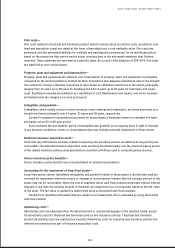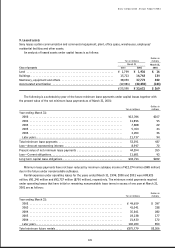Sony 2001 Annual Report Download - page 105
Download and view the complete annual report
Please find page 105 of the 2001 Sony annual report below. You can navigate through the pages in the report by either clicking on the pages listed below, or by using the keyword search tool below to find specific information within the annual report.
Sony Corporation Annual Report 2001
103
After an underlying hedged transaction is settled or ceases to exist, all changes in fair value of related
derivatives which have not been settled are recognized in foreign exchange gains or losses.
Stock-based compensation—
In accordance with Accounting Principles Board Opinion (“APB”) No. 25, “Accounting for Stock Issued to
Employees”, stock-based compensation cost is recognized in income based on the excess, if any, of the quoted
market price of the stock at the grant date of the award or other measurement date over the stated exercise
price of the award.
Free distribution of common stock—
On occasion, Sony Corporation may make a free distribution of common stock which is accounted for either by
a transfer of the applicable par value from additional paid-in capital to the common stock account or with no
entry if free shares are distributed from the portion of previously issued shares accounted for as excess of par
value in the common stock account.
Under the Japanese Commercial Code, a stock dividend can be effected by an appropriation of retained
earnings to the common stock account by resolution of the general shareholders’ meeting, followed by a free
share distribution with respect to the amount appropriated by resolution of the Board of Directors’ meeting.
Free distribution of common stock is recorded in the consolidated financial statements only when it
becomes effective, except for the calculation and presentation of per share amounts.
Net income per share—
Basic net income per share (“EPS”) is computed based on the average number of shares of common stock
outstanding during each period and diluted EPS assumes the dilution that could occur if securities or other
contracts to issue common stock were exercised or converted into common stock or resulted in the issuance of
common stock. EPS for all periods is appropriately adjusted for any free distributions of common stock which
have been completed.
Common stock issue costs—
Common stock issue costs are directly charged to retained earnings, net of tax, in the accompanying consoli-
dated financial statements as the Japanese Commercial Code prohibits charging such stock issue costs to capi-
tal accounts which is the prevailing practice in the United States of America.
(3) Recent pronouncements:
Derivative instruments and hedging activities—
On April 1, 2001, Sony adopted FAS No. 133, “Accounting for Derivative Instruments and Hedging Activities” as
amended by FAS No. 138 “Accounting for Certain Derivative Instruments and Certain Hedging Activities — an
Amendment of FASB statement No. 133”. FAS No. 133, as amended, establishes accounting and reporting
standards for derivative instruments. Specifically, FAS No. 133 requires an entity to recognize all derivatives as
either assets or liabilities in the balance sheet and to measure those instruments at fair value. Additionally, the
fair value adjustments will affect either stockholders’ equity or net income depending on whether the derivative
instrument qualifies as a hedge for accounting purposes and, if so, the nature of the hedging activity. On April 1,
2001, upon the adoption of the new standard, Sony recorded an unrealized gain of ¥1,089 million ($9 million) in
accumulated other comprehensive income and an after-tax gain of ¥5,978 million ($48 million) as the cumulative
effect of an accounting change in the consolidated statement of income for the year ending March 31, 2002.
























